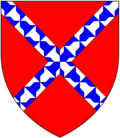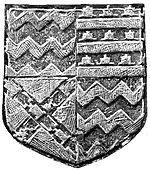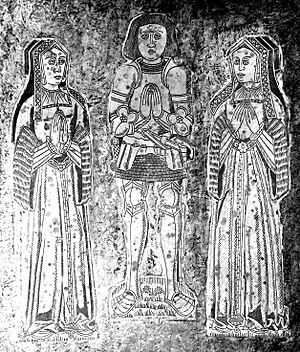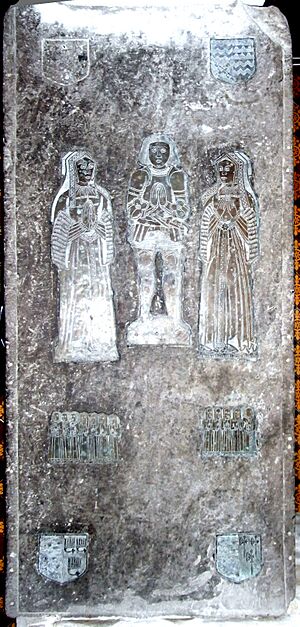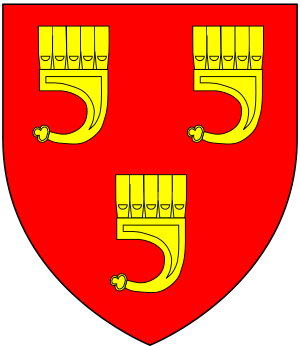John Basset (1462–1528) facts for kids
Sir John Basset (born 1462 – died 1528) was an important person from the West Country in England. He lived in Tehidy, Cornwall and Umberleigh, Devon. He served as the Sheriff of Cornwall three times and Sheriff of Devon once.
Sir John is mostly remembered because of his second wife, Honor Grenville. After Sir John died, Honor married Arthur Plantagenet, 1st Viscount Lisle, who was a son of King Edward IV. This marriage brought Honor into the highest levels of society, close to King Henry VIII.
We know a lot about their lives because of the Lisle Letters. This is a huge collection of letters written to Arthur and Honor. These letters tell us how Honor managed the Basset family lands, like Umberleigh and Tehidy, after Sir John's death. They also include many letters from Sir John's children to Honor.
Contents
Family Background
Sir John Basset was the oldest son of Sir John Basset (1441–1485). His family lived at Tehidy in Cornwall and Whitechapel in Devon. His mother was Elizabeth Budockshyde.
His grandmother, Joan Beaumont, brought important lands into the family. These lands included Umberleigh and Heanton Punchardon. The Basset family itself was one of the first Norman families to settle in England.
Public Service and Key Events
As Sheriff of Cornwall in 1497, Sir John faced a challenge. Rebels from Cornwall attacked and damaged his family home, Tehidy.
In 1501, King Henry VII made him a Knight of the Bath. This happened when the King's son, Prince Arthur, married Katherine of Aragon.
He served as Sheriff of Cornwall again in 1517 and 1522. Then he became Sheriff of Devon in 1524. In 1520, he joined King Henry VIII at the famous Field of Cloth of Gold. This was a grand meeting between the kings of England and France.
Inheriting Lands
Sir John Basset was supposed to inherit many lands from his grandmother, Joan Beaumont. These lands included the important areas of Umberleigh and Heanton Punchardon.
However, Sir John did not have enough money to officially claim these lands. He had to pay large fees to the King. To solve this, he made a special deal in 1504 with Giles Daubeney, 1st Baron Daubeney. This deal was called the "Great Indenture." Daubeney agreed to pay the money needed to get the lands. In return, one of Sir John's daughters would marry Daubeney's young son, Henry Daubeney. The plan was for these lands to then belong to the Daubeney family.
But the marriage never happened. Sir John's first wife died, and he remarried at age 53 to Honor Grenville, who was 22. They had a son, John, who became his heir. Because of this, the Beaumont lands eventually came back to the Basset family.
Family Shields and Symbols
The tomb of Sir John Basset in Atherington Church shows his family's special symbols, called armorials. These symbols are carved on stone shields. They show the Basset family's arms, along with those of the Beaumont and Willington families. These show the important family connections through marriage.
Marriages and Children
Sir John Basset married twice and had 12 children in total. His first wife did not have a son who lived to inherit his lands. This is why he made the deal about his Beaumont inheritance. But then, his first wife died, and he married Honor Grenville. She gave him the son he wanted.
First Marriage
Sir John first married Elizabeth (or Ann) Denys before 1474. She was the daughter of John Denys of Orleigh. They had one son who died young, and four daughters:
- Anne Basset: As a child, she and her sister Thomasine lived with Giles Daubeney, 1st Baron Daubeney as part of the "Great Indenture" agreement. The plan was for her to marry Daubeney's son, but it never happened. In 1511, she married James Courtenay.
- Margery or Mary Basset: She married William Marrys. After William died, their young daughter Margaret became his only heir. A lawyer named George Rolle helped manage Margaret's future.
- Jane Basset: She lived at Umberleigh when her step-mother, Lady Lisle, was away. Jane was very outspoken and watched over the property. She believed some servants were not doing their job well.
- Thomasine Basset (died 1536): Like her sister Anne, she was part of the "Great Indenture" agreement. She also lived at Umberleigh with Jane. She later became ill and died.
Second Marriage
In 1515, when he was 53, Sir John married Honor Grenville (1493–1566). She was the daughter of Sir Thomas Grenville. They had seven children who survived:
- John Basset (1518–1541): He was the oldest son and heir. He married Frances Plantagenet, who was the daughter of his step-father, Arthur Plantagenet. Their son, Sir Arthur Basset, later inherited Umberleigh.
- George Basset (around 1524 – around 1580): He was the second son. He became a MP for different areas in Cornwall.
- James Basset (1526–1558): The third son. He worked for Queen Mary I and built up his own lands.
- Philippa Basset (died 1582): She married James Pitts.
- Katharine Basset (born around 1522): She worked as a servant for Anne of Cleves, one of King Henry VIII's queens. She married Sir Henry Ashley.
- Anne Basset: She was a maid of honour to several of King Henry VIII's queens, including Jane Seymour, Anne of Cleves, Catherine Howard, and Katharine Parr. She was known for her beauty.
- Mary Basset (died 1598): The youngest daughter. She lived in France for a time with a French noble family. She later married John Wollacombe.
Widow's New Life
After Sir John died, his wife Honor married Arthur Plantagenet, 1st Viscount Lisle. He was the illegitimate son of King Edward IV. When Lord Lisle became the Governor of Calais (a French town then controlled by England), Sir John Basset's children moved there and were educated in France.
Honor and Lord Lisle seemed to have a very happy marriage. Honor was a strong woman who wrote many letters to her friends at court. These letters are the famous Lisle Letters, which give us a great look into life during King Henry VIII's time.
Daughters at Court
Honor worked hard to get one of her daughters a position at court. In 1537, her daughter Anne Basset became a maid-of-honour to Queen Jane Seymour. Anne was known for her beauty and good manners.
Anne continued to serve three more queens: Anne of Cleves, Catherine Howard, and Katherine Parr. Even after Lord Lisle was arrested, Anne's sister Katharine and their mother eventually joined her at court.
In 1542, there was talk that King Henry VIII might even consider Anne Basset as his next wife. However, this did not happen. The Basset family continued to serve in the royal courts for many years.
Death and Burial
Sir John Basset died on January 31, 1528, at the age of 66. Some of his children were still very young. His son and heir, John Basset, was only 9 years old. Sir John was buried in his family's private Holy Trinity Chapel near his home at Umberleigh.
His Will
Sir John Basset left a will dated November 6, 1527. In it, he asked for prayers for himself and his wife Honor. He left Honor all the income from several of his lands until she remarried. This money was meant to help pay his debts and provide dowries for his daughters when they married.
His Tomb
His tomb, with special brass pictures on top, is in St Mary's Church, Atherington. It was moved there in 1818 from Umberleigh Chapel. The Lisle Letters tell us how his widow, Lady Lisle, ordered the "images & scripture" for his tomb. The brasses were made in 1533 and placed on the tomb in 1534.
See also
- Baron Basset
- Tehidy Country Park
Sources
- Byrne, Muriel St. Clare, (ed.) The Lisle Letters, 6 vols, University of Chicago Press, Chicago & London, 1981, vol.1, pp. 299–350, "Grenvilles and Bassets" & vol.4, Chapter 7 re "The Great Indenture"
- Vivian, Lt.Col. J.L., (Ed.) The Visitations of the County of Devon: Comprising the Heralds' Visitations of 1531, 1564 & 1620, Exeter, 1895, esp. pp. 45–48, pedigree of Basset


